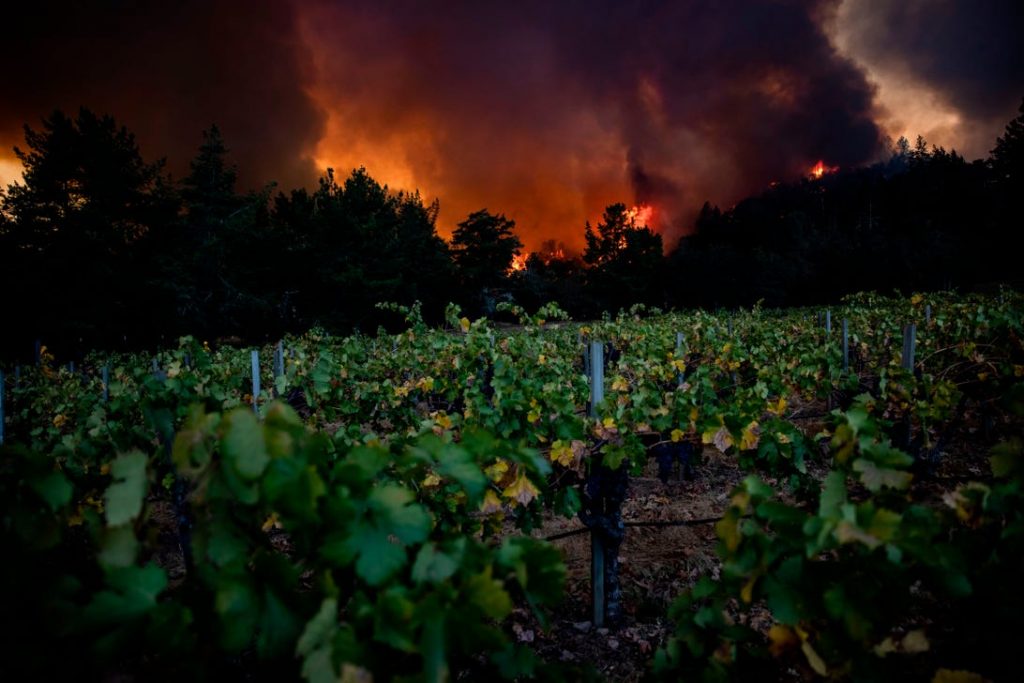The year 2020 left winemakers heartbroken.
As deadly wildfires on the US West Coast ripped through homes and tore apart forests, smoke seeped into world-renowned vineyards in California’s Napa Valley.
Precious grapes, lovingly nurtured in the name of beautiful wine, were ruined by the taste of fumes and grief. But winemakers continued their craft, hoping their grapes were among the few left unscathed. Most vintners weren’t so lucky. Their products were permeated by an acrid flavor, referred to as smoke taint. Wine once meant to go for $100 a bottle could now only be added to blends selling for $5 a gallon.
Looking to avert this sort of catastrophe in the future, especially as the climate crisis exacerbates wildfire rates even further, scientists are studying a clearcut way to chemically analyze which grapes and wines are subject to smoke taint and which aren’t. They published their outline this month in the Journal of Natural Products.
«What I discovered was that proper analytical data was not provided to figure out if the grapes or wines were affected by the smoke,» Phillip Crews, a chemist at UC Santa Cruz and winemaker at Pelican Ranch Winery, said in a statement. Smoke taint was first brought to Crews’ attention in 2018 as a result of the Mendocino Complex Fire aftermath, when wineries began rejecting ruined grapes from the region.
Without such a metric, post-wildfire winemaking and selling calls for a hefty amount of guesswork, like with the 2020 harvest. Thus, tainted grapes are often accidentally turned into wine that then gets rejected, leading to lost product, or tainted wine is sometimes sold under the guise of a good quality offering, resulting in lost reputation.
Basically, Crews and fellow researchers meticulously studied more than 200 grape and wine samples from 21 grape-growing regions in California and Oregon, each exposed to varying levels of smoke. They uncovered several «biomarkers,» or compounds present in the fruit or alcohol, that indicate the item is smoke tainted.
«There are still major gaps in our understanding of these compounds, so more research is needed,» Crews said. «But people can use these procedures now to look at a bottle of wine or a batch of grapes and tell if it’s likely to be affected by smoke taint.»
Searching for spoiled grapes
Right now most available research into smoke taint, per the study, focuses on smoke-derived compounds called volatile phenols.
These molecules are present in fumes from burning vegetation, such as trees during wildfires. Ripening grape skin can absorb these compounds, which is why it makes sense to check out grapes for these phenols — if they’re there, you’d think it’s safe to say the grapes are smoke tainted.
But Crews says identifying only the phenols doesn’t offer a full picture of smoke taintedness. There’s a caveat. Once inside grapes, the phenols bind to sugars and form totally new structures known as phenolic diglycosides that leave the smoke taint undetectable. That’s why it’s so hard to tell which grapes are affected and which aren’t. However, as soon as compromised products hit certain enzymes, such as those present in our saliva, the unwanted taint is released.
«We found that the phenolic diglycosides are stable in cabernet sauvignon during bottle aging, but then, during tasting, the monomers that smell bad get released in the mouth,» Crews said.
This is why Crews says scientists must measure the phenolic diglycosides directly, instead of relying on the ever-changing volatile phenols. That way, the smoke taintedness can be definitively detected prior to tasting. Through sophisticated chemistry methods, such as quantitative mass spectrometry, the study researchers pinpointed several biomarkers associated with phenolic diglycosides in their samples of grapes and wine.
«This research is highly valuable, with the potential to save countless dollars, and is increasingly relevant in our world of drought and climate change,» Eleni Papadakis, a winemaking consultant in Portland, Oregon, who wasn’t directly involved in the study, said in a statement.
She added, «I believe I speak for the whole of the winemaking community when I express the excitement and appreciation for the strong data and evidence-based guidance Professor Crews and his team have provided with this groundbreaking work.»
